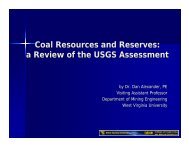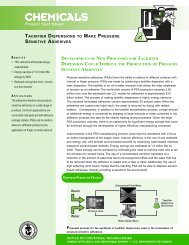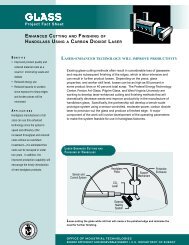PROCEEDINGS - Industries of the Future - West Virginia - West ...
PROCEEDINGS - Industries of the Future - West Virginia - West ...
PROCEEDINGS - Industries of the Future - West Virginia - West ...
Create successful ePaper yourself
Turn your PDF publications into a flip-book with our unique Google optimized e-Paper software.
Inaugural Symposium Proceedings<br />
our transportation system more efficient? We would really like to believe, as an industry, that we are<br />
part <strong>of</strong> this solution, and not part <strong>of</strong> <strong>the</strong> problem.<br />
I’d like to turn now to <strong>the</strong> second thing, that is <strong>the</strong> Northwest Alliance for Transportation<br />
Technology (NATT). This is a group which has been spawned out <strong>of</strong> <strong>the</strong> Battelle Pacific Northwest<br />
Lab. What happened in <strong>the</strong> Northwest earlier this year was a very similar meeting to this. A gentleman<br />
called Gary McVey, who was <strong>the</strong> equivalent <strong>of</strong> Carl, convened about 140 people in <strong>the</strong> Seattle area.<br />
What <strong>the</strong>y want to do <strong>the</strong>re is develop a synergy between <strong>the</strong> local or regional industries in <strong>the</strong> Pacific<br />
Northwest. Somebody had a gleam in his eye to say it would be very important, given that it has been<br />
a traditional center for energy production, that a lot <strong>of</strong> <strong>the</strong> aluminum industry is located <strong>the</strong>re, 40% in<br />
fact is located in <strong>the</strong> Pacific Northwest, that <strong>the</strong>re is also magnesium and titanium production <strong>the</strong>re, and<br />
recognizing that it is important for non-ferrous materials to be increased in <strong>the</strong> automotive area, to<br />
develop a sub-component or sub-assembly plant for automotive production in <strong>the</strong> Pacific Northwest.<br />
That’s <strong>the</strong> long-term dream with which <strong>the</strong>y have come up. In order to pursue that, <strong>the</strong>y <strong>the</strong>n attracted<br />
<strong>the</strong> PACCARs, <strong>the</strong> Freightliners and <strong>the</strong> truck trailer business. They attracted <strong>the</strong> aluminum industry<br />
and <strong>the</strong> energy producing industry. They invited Boeing. They got <strong>the</strong> local ship building group<br />
toge<strong>the</strong>r. Everybody who was in <strong>the</strong> manufacturing <strong>of</strong> metallic systems came toge<strong>the</strong>r. They have<br />
succeeded in having a line item in <strong>the</strong> budget. Last year <strong>the</strong>y had $2 ½ million associated with this.<br />
This year, I think it’s gone up to about $5 million. They’ve got tremendous support from Senator Slade<br />
Gordon, and <strong>the</strong>re was a lot <strong>of</strong> political representation at this meeting. Secretary Penya made an<br />
excellent keynote address. What I think is happening <strong>the</strong>re is that one plus one doesn’t equal two, but<br />
one plus one equals three. The challenge for this group is to search for <strong>the</strong> synergy in what your<br />
collective industries do, see where <strong>the</strong> common features are, and <strong>the</strong>n combine around those common<br />
threads. See if one can develop partnerships and activities with those common threads, and in that way<br />
build a common vision.<br />
Well, that was what I wanted to say in sharing some thoughts about our roadmap experience and about<br />
what NATT is doing. If <strong>the</strong>re are any comments or questions, I’d be happy to take <strong>the</strong>m now or later.<br />
Moderator: Thank you. Our next speaker is Brian Joseph.<br />
Joseph: First, a little bit about what we do. If you look at our facility we have lots <strong>of</strong> equipment. I<br />
think <strong>the</strong>re are five electron microscopes, mechanical testing laboratories, metallurgical labs, chemistry<br />
labs, industrial microbiology labs; it’s very, very diverse in terms <strong>of</strong> <strong>the</strong> kinds <strong>of</strong> facilities we have. We<br />
also run all <strong>the</strong> quality control for <strong>the</strong> Ohio Coatings Corporation, which is a new state-<strong>of</strong>-<strong>the</strong>-art tin mill<br />
in eastern Ohio. We’ll be doing <strong>the</strong>ir R&D as that kicks in. We have an SEM inside <strong>the</strong> plant that I’m<br />
going to talk about in a minute.<br />
We set <strong>the</strong> lab up to do two primary things— very fast product development, very applied<br />
research and development, and to solve manufacturing problems. Today, we start one to two new<br />
projects a day, every day <strong>of</strong> <strong>the</strong> week, solving manufacturing problems from every industry that has<br />
been mentioned here and many o<strong>the</strong>r industries. For United Technologies you mentioned earlier we’ve<br />
qualified virtually all <strong>the</strong> materials that fly on <strong>the</strong> solid fuel rocket booster <strong>of</strong> <strong>the</strong> space shuttle. So we’ve<br />
tested adhesives, paints and o-rings. It all started after <strong>the</strong> Challenger accident and <strong>the</strong>y came to us and<br />
28






